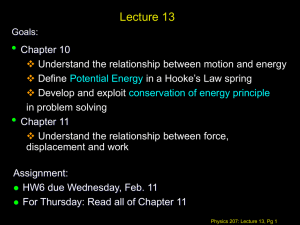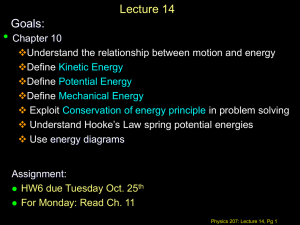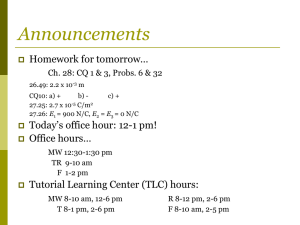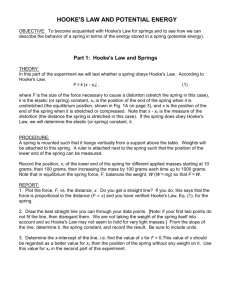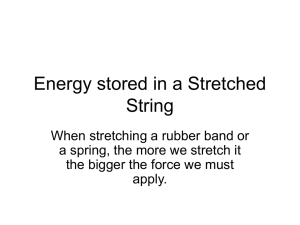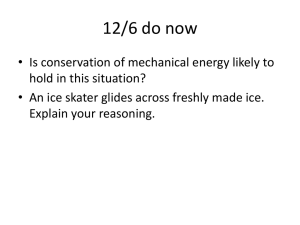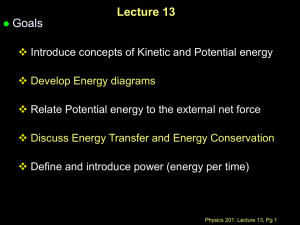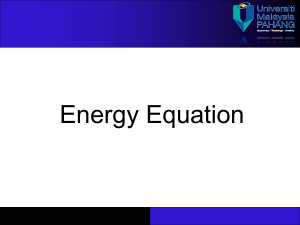sy14_oct20_f10
advertisement
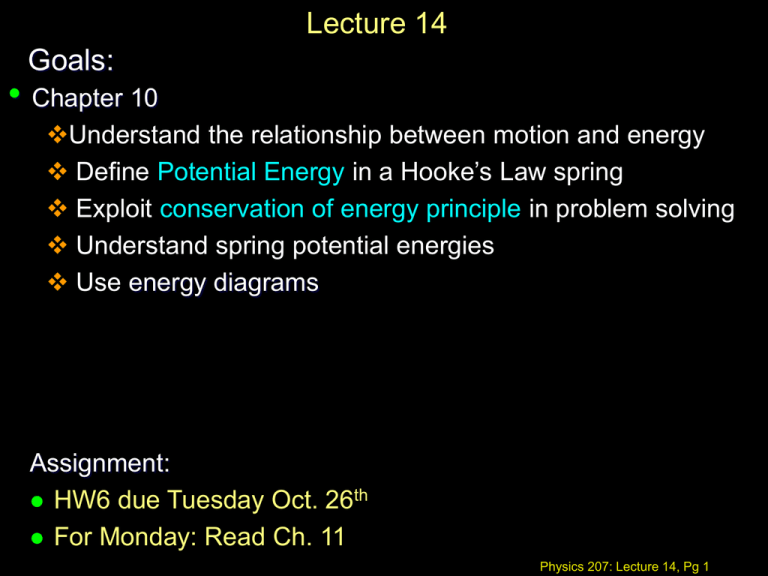
Lecture 14 Goals: • Chapter 10 Understand the relationship between motion and energy Define Potential Energy in a Hooke’s Law spring Exploit conservation of energy principle in problem solving Understand spring potential energies Use energy diagrams Assignment: HW6 due Tuesday Oct. 26th For Monday: Read Ch. 11 Physics 207: Lecture 14, Pg 1 Energy -mg Dy= ½ m (vy2 - vy02 ) -mg (yf – yi) = ½ m ( vyf2 -vyi2 ) A relationship between y- displacement and change in the y-speed squared Rearranging to give initial on the left and final on the right ½ m vyi2 + mgyi = ½ m vyf2 + mgyf We now define mgy = U as the “gravitational potential energy” Physics 207: Lecture 14, Pg 2 Energy Notice that if we only consider gravity as the external force then the x and z velocities remain constant To ½ m vyi2 + mgyi = ½ m vyf2 + mgyf Add ½ m vxi2 + ½ m vzi2 and ½ m vxf2 + ½ m vzf2 ½ m vi2 + mgyi = ½ m vf2 + mgyf where vi2 ≡ vxi2 +vyi2 + vzi2 ½ m v2 = K terms are defined to be kinetic energies (A scalar quantity of motion) Physics 207: Lecture 14, Pg 3 Reading Quiz What is the SI unit of energy A erg B dyne CNs D calorie E Joule Physics 207: Lecture 14, Pg 4 Inelastic collision in 1-D: Example 1 A block of mass M is initially at rest on a frictionless horizontal surface. A bullet of mass m is fired at the block with a muzzle velocity (speed) v. The bullet lodges in the block, and the block ends up with a speed V. What is the initial energy of the system ? What is the final energy of the system ? Is energy conserved? x v V before after Physics 207: Lecture 14, Pg 5 Inelastic collision in 1-D: Example 1 mv What is the momentum of the bullet with speed v ? 1 2 mv v mv 2 2 1 2 (m M )V 2 1 What is the initial energy of the system ? What is the final energy of the system ? Is momentum conserved (yes)? mv M 0 (m M )V Is energy conserved? Examine Ebefore-Eafter 2 mv 2 1 [( m M )V]V 2 1 2 v mv 2 1 ( mv) 2 m mM v 1 mv 2 No! before 2 (1 m mM ) V after x 1 Physics 207: Lecture 14, Pg 6 Elastic vs. Inelastic Collisions A collision is said to be inelastic when “mechanical” energy ( K +U ) is not conserved before and after the collision. How, if no net Force then momentum will be conserved. Kbefore Kafter E.g. car crashes on ice: Collisions where objects stick together A collision is said to be elastic when both energy & momentum are conserved before and after the collision. Kbefore = Kafter Carts colliding with a perfect spring, billiard balls, etc. Physics 207: Lecture 14, Pg 7 Kinetic & Potential energies Kinetic energy, K = ½ mv2, is defined to be the large scale collective motion of one or a set of masses Potential energy, U, is defined to be the “hidden” energy in an object which, in principle, can be converted back to kinetic energy Mechanical energy, EMech, is defined to be the sum of U and K. Physics 207: Lecture 14, Pg 8 Energy If only “conservative” forces are present, the total mechanical energy (sum of potential, U, and kinetic energies, K) of a system is conserved For an object in a gravitational “field” ½ m vyi2 + mgyi = ½ m vyf2 + mgyf K ≡ ½ mv2 U ≡ mgy Emech = K + U Emech = K + U = constant K and U may change, but Emech = K + U remains a fixed value. Emech is called “mechanical energy” Physics 207: Lecture 14, Pg 9 Example of a conservative system: The simple pendulum. Suppose we release a mass m from rest a distance h1 above its lowest possible point. What is the maximum speed of the mass and where does this happen ? To what height h2 does it rise on the other side ? m h1 h2 v Physics 207: Lecture 14, Pg 10 Example: The simple pendulum. What is the maximum speed of the mass and where does this happen ? E = K + U = constant and so K is maximum when U is a minimum. y y=h1 y= 0 Physics 207: Lecture 14, Pg 11 Example: The simple pendulum. What is the maximum speed of the mass and where does this happen ? E = K + U = constant and so K is maximum when U is a minimum E = mgh1 at top E = mgh1 = ½ mv2 at bottom of the swing y y=h1 y=0 h1 v Physics 207: Lecture 14, Pg 12 Example: The simple pendulum. To what height h2 does it rise on the other side? E = K + U = constant and so when U is maximum again (when K = 0) it will be at its highest point. E = mgh1 = mgh2 or h1 = h2 y y=h1=h2 y=0 Physics 207: Lecture 14, Pg 13 Potential Energy, Energy Transfer and Path A ball of mass m, initially at rest, is released and follows three difference paths. All surfaces are frictionless 1. The ball is dropped 2. The ball slides down a straight incline 3. The ball slides down a curved incline After traveling a vertical distance h, how do the three speeds compare? 1 2 3 h (A) 1 > 2 > 3 (B) 3 > 2 > 1 (C) 3 = 2 = 1 (D) Can’t tell Physics 207: Lecture 14, Pg 14 Potential Energy, Energy Transfer and Path A ball of mass m, initially at rest, is released and follows three difference paths. All surfaces are frictionless 1. The ball is dropped 2. The ball slides down a straight incline 3. The ball slides down a curved incline After traveling a vertical distance h, how do the three speeds compare? 1 2 3 h (A) 1 > 2 > 3 (B) 3 > 2 > 1 (C) 3 = 2 = 1 (D) Can’t tell Physics 207: Lecture 14, Pg 15 Example The Loop-the-Loop … again To complete the loop the loop, how high do we have to let the release the car? Condition for completing the loop the loop: Circular motion at the top of the loop (ac = v2 / R) Exploit the fact that E = U + K = constant ! (frictionless) Ub=mgh U=mg2R h? y=0(A) 2R U=0 Recall that “g” is the source of Car has mass m the centripetal acceleration and N just goes to zero is the limiting case. Also recall the minimum speed at the top is R (B) 3R (C) 5/2 R (D) 23/2 R v gR Physics 207: Lecture 14, Pg 16 Example The Loop-the-Loop … again Use E = K + U = constant mgh + 0 = mg 2R + ½ mv2 mgh = mg 2R + ½ mgR = 5/2 mgR v gR h = 5/2 R h? R Physics 207: Lecture 14, Pg 17 Variable force devices: Hooke’s Law Springs Springs are everywhere, (probe microscopes, DNA, an effective interaction between atoms) Rest or equilibrium position F Du In this spring, the magnitude of the force increases as the spring is further compressed (a displacement). Hooke’s Law, Fs = - k Du Ds is the amount the spring is stretched or compressed from it resting position. Physics 207: Lecture 14, Pg 23 Exercise Hooke’s Law 8m 9m What is the spring constant “k” ? 50 kg (A) 50 N/m (B) 100 N/m (C) 400 N/m (D) 500 N/m Physics 207: Lecture 14, Pg 25 Exercise 2 Hooke’s Law 8m 9m What is the spring constant “k” ? Fspring 50 kg (A) 50 N/m SF = 0 = Fs – mg = k Du - mg Use k = mg/Du = 500 N / 1.0 m (B) 100 N/m (C) 400 N/m (D) 500 N/m mg Physics 207: Lecture 14, Pg 26 Force vs. Energy for a Hooke’s Law spring F = - k (x – xequilibrium) F = ma = m dv/dt = m (dv/dx dx/dt) = m dv/dx v = mv dv/dx So - k (x – xequilibrium) dx = mv dv Let u = x – xeq. & du = dx m uf ku du mv dv ui 1 2 1 2 vf 1 2 vi ku |u 2 mv |v 2 uf 2 vf 1 i i ku f 2 kui 2 mv f 2 mvi 2 1 2 1 2 1 kui 2 mvi 2 ku f 2 mv f 2 1 2 1 2 1 2 Physics 207: Lecture 14, Pg 27 2 Energy for a Hooke’s Law spring ku mv ku mv i i f f 2 2 2 2 1 2 1 2 1 2 Associate ½ ku2 with the “potential energy” of the spring 1 2 m U si K i U sf K f Ideal Hooke’s Law springs are conservative so the mechanical energy is constant Physics 207: Lecture 14, Pg 28 Energy diagrams In general: Ball falling Spring/Mass system Emech Emech K U Energy Energy K 0 y U 0 u = x - xeq Physics 207: Lecture 14, Pg 29 Equilibrium Example Spring: Fx = 0 => dU / dx = 0 for x=xeq The spring is in equilibrium position In general: dU / dx = 0 for ANY function establishes equilibrium U stable equilibrium U unstable equilibrium Physics 207: Lecture 14, Pg 31 Recap Assignment: HW6 due Tuesday Oct. 26th For Monday: Read Ch. 11 Physics 207: Lecture 14, Pg 35
